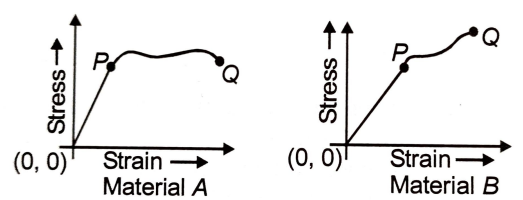A wire of length \(L,\) area of cross section \(A\) is hanging from a fixed support. The length of the wire changes to \({L}_1\) when mass \(M\) is suspended from its free end. The expression for Young's modulus is:
1.
\(\dfrac{{Mg(L}_1-{L)}}{{AL}}\)
2.
\(\dfrac{{MgL}}{{AL}_1}\)
3.
\(\dfrac{{MgL}}{{A(L}_1-{L})}\)
4.
\(\dfrac{{MgL}_1}{{AL}}\)
The stress versus strain graph is shown for two wires. If \(Y_1\) and \(Y_2\) are Young modulus of wire \(A\) and \(B\) respectively, then the correct option is:

| 1. | \(Y_1>Y_2\) | 2. | \(Y_2>Y_1\) |
| 3. | \(Y_1=Y_2\) | 4. | cannot say |
The stress-strain graphs for materials \(A\) and \(B\) are shown in the figure. Young’s modulus of material \(A\) is:
(the graphs are drawn to the same scale)

| 1. | equal to material \(B\) |
| 2. | less than material \(B\) |
| 3. | greater than material \(B\) |
| 4. | can't say |
The edge of an aluminum cube is \(10~\text{cm}\) long. One face of the cube is firmly fixed to a vertical wall. A mass of \(100~\text{kg}\) is then attached to the opposite face of the cube. The shear modulus of aluminum is \(25~\text{GPa}.\) What is the vertical deflection of this face?
1. \(4.86\times 10^{-6}~\text{m}\)
2. \(3.92\times 10^{-7}~\text{m}\)
3. \(3.01\times 10^{-7}~\text{m}\)
4. \(6.36\times 10^{-7}~\text{m}\)
1. \(7.06\times 10^{4}~\text{N}\)
2. \(5.03\times 10^{4}~\text{N}\)
3. \(1.09\times 10^{4}~\text{N}\)
4. \(17\times 10^{4}~\text{N}\)
The volume contraction of a solid copper cube, \(10~\text{cm}\) on an edge, when subjected to a hydraulic pressure of \(7.0\times10^6~\text{Pa}\) is:
(Bulk modulus of copper is \(140 \times10^{9}~\text{Pa}.\))
1. \( 3.1 \times 10^{-2} ~\text{m}^3 \)
2. \(9.1 \times 10^{-3} ~\text{cm}^3 \)
3. \(5.0 \times 10^{-2} ~\text{cm}^3 \)
4. \(7.9 \times 10^{-2} ~\text{cm}^3 \)
Hooke's law is applicable for:
| 1. | elastic materials only | 2. | plastic materials only |
| 3. | elastomers only | 4. | all of these |
If two different types of rubber are found to have stress-strain curves as shown, then:
| 1. | A is suitable for shock absorbers. |
| 2. | B is suitable for shock absorbers. |
| 3. | B is suitable for car tires. |
| 4. | None of these |
The stress-strain graphs for two materials \(A\) and \(B\) are shown in the figure. The graphs are drawn to the same scale.

Select the correct statement:
| 1. | material \(A\) has a greater Young's Modulus. |
| 2. | material \(A\) is ductile. |
| 3. | material \(B\) is brittle. |
| 4. | all of these. |
On withdrawing the external applied force on bodies within the elastic limit, the body:
| 1. | regains its previous state very quickly |
| 2. | regains its previous state after some time |
| 3. | regains its previous state after a very long time |
| 4. | does not regain its previous state |







